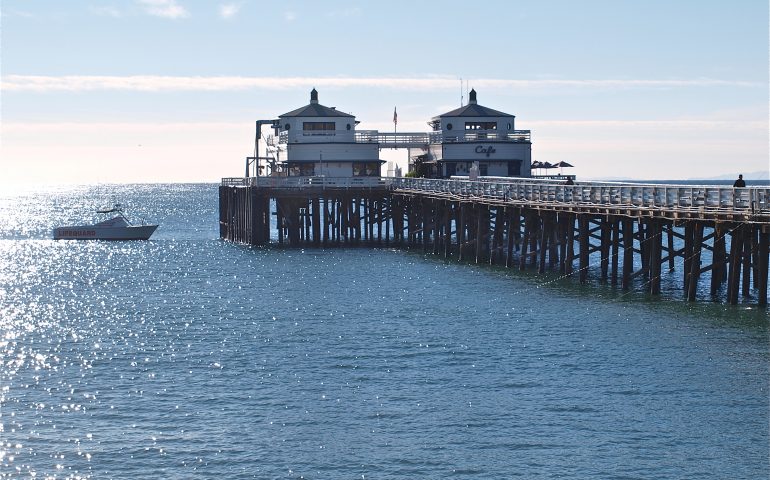Rindge built the pier and a nearby terminus for the railroad. Supplies for the ranch could be quickly unloaded from ships at the pier and loaded onto the rail cars while a reverse operation shipped out products from the ranch. Eventually that pier, like most early piers and wharves along the coast, would be lost to storms and waves.
A narrow new pier was then built and primarily used for docking yachts although people also used it for fishing. Author Zane Grey may have been the most famous—and certainly one of the most successful. Bill Beebe, the esteemed, long-time writer at the Los Angeles Times, mentioned in a letter, “Overlooked in your great book [Pier Fishing In California, 2nd Ed.] was the many huge black seabass that Zane Grey caught from the end of the old Malibu Pier in the ‘20s. He would have a helper take his baited line in a rowboat and row a hundred yards, or so, from the pier and let the bait sink. As I recall, many of those blacks weighed more than 300 pounds.”
Rindge’s widow, Rhoda May Rindge, fought the railroads and the state for many years trying to keep her property closed to outsiders but finally, after 17 years of court battles, the state won and was able to start construction of the Roosevelt Highway (today’s Pacific Coast Highway). It opened to the public between Santa Monica and Oxnard in June 1929.
In the 1920s, Mrs. Rindge began to lease property north of Malibu Creek. Initial lots were leased to several movie personalities along a strand of beach known as the Malibu Colony. Leases would last for ten years.
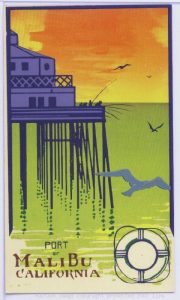
A poster from the 1930s
The pier was widened and lengthened by the Rindge family in the early ‘30s. In 1934 leases were granted to Sportfishing concessionaires and the pier was opened to the public for recreational fishing. Various charter boats, party boats, and barges would call the pier their home over the years but the first appears to have been the barge Minnie A. Caine. Later barges included the Annie M. Rolph (1937), the Virginia (1938), and the Hippoglossus.
The pier apparently became a favorite source of fish for out-of-work Depression-era anglers looking for food. However, not all the anglers were destitute. It’s recorded that movie stars Clark Gable, Cesar Romero, and Buster Crabbe (among others) would stroll over to the pier, fishing rods in hand, from their Malibu Colony homes and perhaps for that reason the pier gained the nickname “Movie Colony Pier,” a nickname used in the newspapers until (at least) the mid-60s.
In 1936 the Rindge’s land operation (Marblehead Land Co,) went bankrupt and was taken over by bondholders who had helped finance operations. Soon after, the pier was lengthened and, by 1938, a small bait and tackle shop had been added at the ocean end of the pier.
Malibu—For the last three days all units have been bringing in fish, 20 bass to a man on the live bait boats as well as halibut and barracuda. Barge and row boats are getting white seabass and good halibut and barracuda catches. Plenty of halibut are being caught from the pier. —Earl Wilcox, Fishing News, The Van Nuys News, May 20, 1937
Malibu—Bass and halibut are the leaders at Malibu. Mackerel is plentiful for the first time this season. Halibut are especially good from the barges. Pier fishing is improving with good catches of halibut being made daily. Last Sunday saw a good run of spotfin croaker and several were hooked by the pier anglers. —Earl Wilcox, Fishing News, The Van Nuys News, August 4, 1938
Ocean Fishing Malibu—The three barges are offering excellent halibut fishing with good barracuda and mackerel catches being made… Pier fishing is picking up with good catches of halibut being made. Surf fishing on the pier is bringing in corbina and perch. —Earl Wilcox, Fishing News, The Van Nuys News, July 7, 1938
Malibu—Bass and halibut and some barracuda are the main catches on the live bait boats. Two albacore were landed by a charter party on the “Miss California II” in the channel out from Point Dume one day last week. Some white seabass have been taken on the barge “Virginia.” Halibut are plentiful from the barges. Spotfin croaker are being taken by pier fishermen. —Earl Wilcox, Fishing News, The Van Nuys News, August 11, 1938
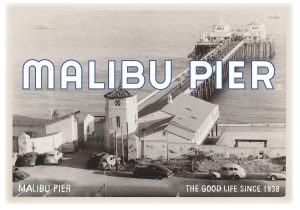
Malibu, a favorite beach-spot of cinema celebrities is well-protected against sight-seers and autograph hunters by uniformed guards stationed at all entrances. Its dwellings, some of elaborate scale, sit facing the beach with their backs turned aloofly to the highway… Malibu Pier (pier fishing 25 cents, all day boat fishing trips $2). —California, A Guide To the Golden State, Federal Writers Project, Works Progress Administration, 1939
The pier served as a lookout station for the U.S. Coast Guard during the early part of World War II but a winter storm in 1943-1944 destroyed the end of the pier (including the bait and tackle shop). The jagged remains of the pier were sold to William Huber and his Malibu Pier Company for $50,000 with the understanding that he would reconstruct the pier and build a building for the Coast Guard’s use. Soon the pier (now at 720 or 735 feet in length depending upon whom you want to believe) was back up and running. At the end of the war, Huber extended the pier to 780 feet and built the twin Cape Cod-style buildings at the end of the pier—one to be used as a restaurant, one to be used as a bait and tackle shop. The pier reopened to visitors on the Fourth of July. For a period of time, Versal Schuler ran the Sportfishing boat Indiana from the pier.
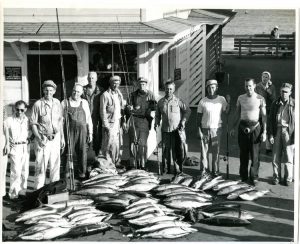
Malibu Pier Sportfishing — 1945
During the ‘50s the pier with its restaurant and bar was an increasingly popular scene for socializing but fishing always remained a key ingredient at the pier. A Department of Fish and Game publication in 1953 mentions that “In 1952 there were three party boats and one charter boat operating from the pier and there were two anchored fishing barges off the coast.” Sportfishing would be available at the pier until the early ‘60s; one of the last boats was the Lenbrooke.
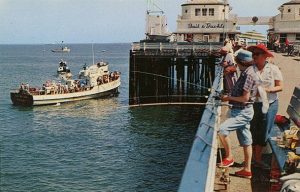
The land-end building near the front of the pier, originally built for the Coast Guard, later became the Malibu Sports Club Restaurant (1966), the Malibu Pier Club (after a change in ownership), and eventually Alice’s Restaurant with its stained glass doors (1972 until closure of the pier).
In 1980 a real estate auction offered the pier to the highest bidder and bids were received for $3 million and $3.1 million. However, Huber refused to sell. Later that same year he did sell the pier to the State of California.
The California Department of Parks and Recreation now operated the pier and was lessor to the operations on the pier. Gigantic El Niño storms in the winter of 1983 inflicted heavy damage to the pier but again the pier was renovated and seemed in fairly good condition.
In 1985 the Los Angeles County Board of Supervisors voted unanimously to recommend the pier for registration as a Point of Historical Interest. Which was done.
“The Malibu Pier is historically significant and one of the great piers of the State of California.” —John Foster, Senior State Archaeologist, California State Parks
Huge El Niño storms struck in January of 1995. This time the pier was declared unsafe and closed. In addition, the state seemed unwilling to make the needed repairs. 1997 saw the state lease the pier to the City of Malibu with the understanding that the city would fix and maintain the pier. Study and debate ensued. What was needed? Should a new pier be built? Should the pier be concrete or wood? Should the pier retain its Cape Cod-like appearance? Surveys were done, decisions were made, and it was decided that $3.6 million dollars was needed to rebuild the pier. However there was one little problem—the city was unable to raise the money and the pier changed hands once again, reverting back to the state.
Rotting Landmark Pier Gives Malibu a Sinking Feeling
Malibu—The city of Malibu is grappling over what to do with its closed and crippled pier as the predicted winter storms of El Niño loom. The landmark pier—built in 1906 and long a favorite backdrop for movies—is rotting and must be repaired if it to have more than a fighting chance of withstanding severe surf lashings.
City officials acquired a 30-year lease on the pier from the state about three months ago and had hoped to rehabilitate it with county bond money. Now they fear that the structure is so weak that the surf may tear it apart this winter, sending busted pilings into seaside homes like missiles.
The three choices confronting the city are all expensive. It would cost $1 million to $2 million and require two months to tear down the pier. Several hundred thousand dollars would have to be invested on reinforcements just to get through the winter. Or the city could walk away from its lease and turn the pier back over to the state, making the state fiscally responsible for any mishaps.
The Malibu City Council is under pressure to make a decision soon. Said City Manager Harry Peacock: We’re not making any progress on this. And the longer we wait, the more of a chance of a storm coming up” with the city left holding the bag.In July, the city initiated what seemed to be an attractive plan to reopen the neglected pier. The city leased the pier from the state essentially rent-free, said Russ Guiney, Malibu sector superintendent for the state’s Department of Parks and Recreation, which had been managing the pier. At the same time, the city approached the county for a $2.9 million grant, with the funds seemingly available under 1992’s Proposition A. With its new lease and funds, the city planned to rehabilitate the pier and reopen it to the public.
But the pier is on virtual life support, creating a new, tempestuous chapter in its 90-year history. It was gutted in a 1942 storm and later rebuilt to serve as a World War II Coast Guard station before being acquired by the state in 1980… The pier is now described as “a derelict” by John Clement, Malibu’s director of public works. The problem, Clement said, is that in its 17 years of management, the state allowed the pier’s infrastructure to rot until a major storm forced the attraction’s closure in January 1995. Now, city officials are not certain the pier is sound enough to hold heavy equipment, Clement said. “Repairing the structure from floating barges, on the other hand, would be prohibitively expensive,” he said. —Joseph Hanania, Los Angeles Times, November 15, 1997
No matter the problems, reconstruction by the state began in 1999 with a $6.2 million budget. Part of the pier was reopened for a time in mid-2000, then it was closed again, and the pier was scheduled to reopen in the spring of 2001. It did finally open but only out to where the pier widens. Fights over the pier continued until 2007 (see below) even though construction continued. Most of the pier was opened to anglers in 2006.
The multi-million dollar reconstruction included replacement of 75% of the pilings, new bracing, new decking, and rails. Wherever possible, an attempt was made to keep the original look (even to using some of the original Malibu Tile) in the buildings.
Malibu Pier buildings remain empty; visitors still enjoy pier fishing
In a world of change, one thing remains constant in the infamous Southern Californian city of Malibu: the Malibu Pier. While the pier has withstood El Nino storms and massive reconstruction, it sill hasn’t overcome one problem: bringing in business.
Malibu residents have been repeatedly promised that businesses will open on the pier. Bill Robinson, captain of Los Angeles County lifeguard operations said the most difficult part of waiting for businesses to return is disappointing residents who are expecting changes.
“The most disappointing thing for me is that everyone asks me when [the pier] is going to open and we tell them, ‘next month,’” Robinson said. “Then the next month comes around and nothing happens, and we have to tell the same people over and over that the pier is closed.”
